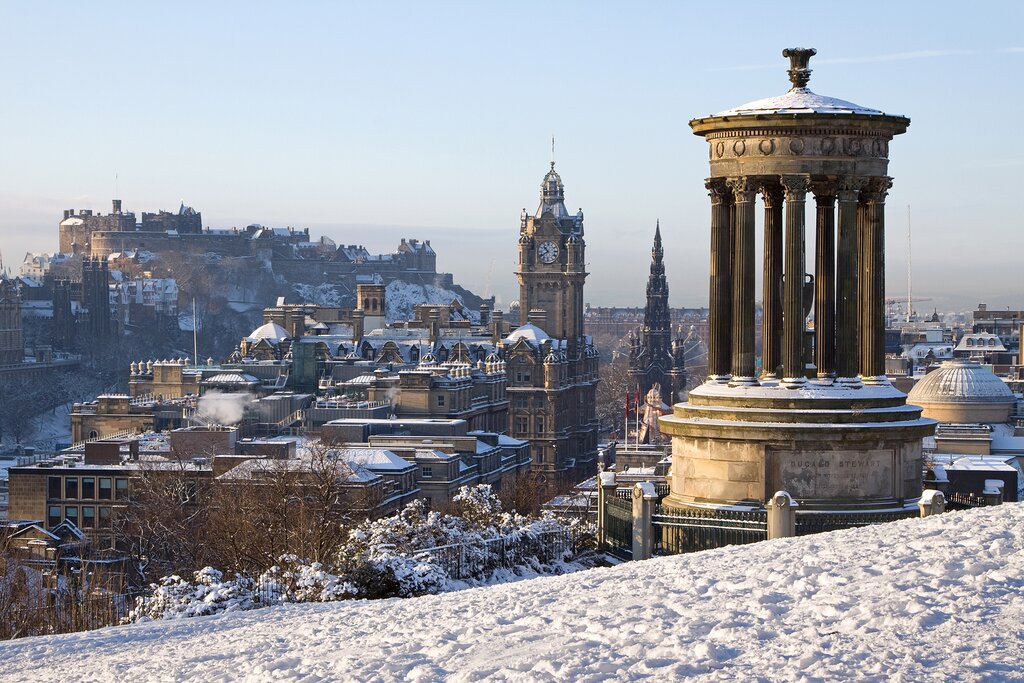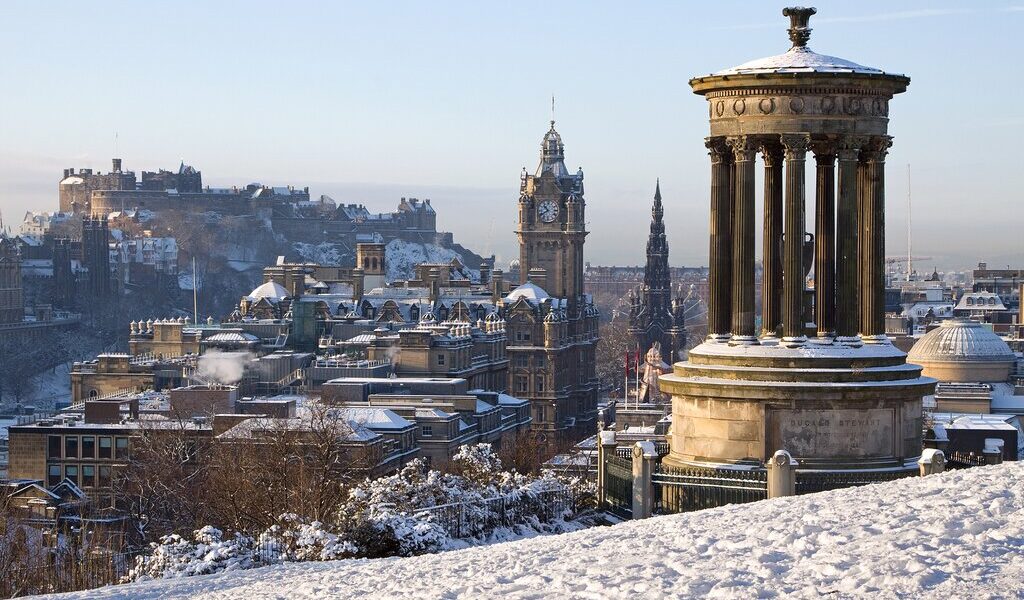
February is a cold and potentially snowy month to visit Scotland; still, it’s easy to stay warm with uncrowded cultural attractions, whisky distilleries, and a vast wilderness offering endorphin-inducing activities (and lengthening daylight hours to enjoy them). In fact, this month is Fort William’s annual mountain festival for the ultimate fix of outdoor inspiration.
## Scotland in February: A Comprehensive Travel Guide
**Weather in Scotland During February**
February in Scotland sees winter firmly entrenched, painting the landscapes in hues of white and grey. The Scottish climate, already known for its unpredictable nature, becomes even more capricious during this month. However, there’s a silver lining: the days are gradually lengthening, offering more daylight for exploration. By the end of February, you can expect over ten hours of daylight each day, a welcome change from the shorter days of December and January.
While temperatures are undeniably cold, they are often less severe than those experienced in many landlocked European countries. This is largely thanks to the moderating influence of the Gulf Stream and Scotland’s prevailing westerly winds. These winds, sweeping in from the North Atlantic, bring in temperate air, which in turn leads to increased cloud cover and frequent rainfall, particularly on the western side of the country.
The eastern regions of Scotland, being further removed from the Atlantic’s influence, tend to experience less rainfall than the west. They also tend to be a touch colder. For example, in Edinburgh, the nation’s capital, the average daily high temperatures typically reach around 45°F (7°C), while the lows hover just above freezing at 34°F (1°C). Scotland’s largest city, Glasgow, benefits from slightly milder temperatures, with average highs reaching 46°F (8°C) and lows around 36°F (2°C) during February. These slight variations are due to Glasgow’s more sheltered location.
Regardless of where your travels take you within Scotland, it is essential to be prepared for a variety of weather conditions, as the weather can change dramatically from one day to the next, or even within the same day. Packing appropriately is key to enjoying your trip comfortably. Consider bringing warm, waterproof layers to protect you from the elements. A hat and gloves are essential for keeping warm, and thick socks will help keep your feet dry and comfortable. Sturdy, waterproof footwear is a must, especially if you plan on doing any walking or hiking. For those planning more active pursuits, such as walks and jogs in the countryside, thermal underwear can provide an extra layer of warmth. If you intend to venture into mountainous areas, proper winter gear is absolutely essential to ensure your safety and comfort.
**Crowds and Costs in February**
February is considered a quieter time to travel to Scotland, offering a more peaceful and less crowded experience. This makes it an ideal time for those seeking tranquility and a break from the hustle and bustle of everyday life. As a result of the lower demand, you can often find better deals on flights and accommodations. Many travelers choose winter as an ideal season to plan an affordable city break or a secluded, romantic escape, particularly around Valentine’s Day, amidst Scotland’s majestic wilderness. Imagine cozying up by a fireplace in a remote cabin, surrounded by snow-covered landscapes!
To secure the best prices on flights, hotels, and activities, it is advisable to book well in advance. This is especially important if you are planning a trip around Valentine’s Day, as popular destinations and accommodations tend to fill up quickly. It’s also a good idea to check the opening hours and availability of attractions before heading out, as some may be closed or operating on a limited schedule during the winter season. Careful planning can help you avoid disappointment and ensure a smooth and enjoyable trip.
**Where to Go in Scotland**
Scotland, occupying the northern half of Great Britain, boasts a dramatic and diverse geography, including over 900 offshore islands. With so much to see and do, it can be overwhelming to decide where to begin. A helpful way to organize your trip is to divide the country into two main regions: the Highlands and the Lowlands.
Many visitors choose to begin and end their journey in the Lowlands, particularly in the two largest cities, Glasgow and Edinburgh, which are conveniently located less than an hour apart by train. Winter is an excellent time to dedicate several days or more to exploring either city, or both! You can enjoy visiting the landmarks and attractions without the usual summer crowds. Imagine strolling through the historic streets of Edinburgh, admiring the architecture without the throngs of tourists.
From either Glasgow or Edinburgh, you can also easily add a day trip to Scotland’s oldest university town, St Andrews, famous for its golf courses and picturesque coastal scenery. Another popular day trip destination is Stirling Castle, one of the country’s largest and most historically significant castles, offering stunning views of the surrounding landscape.
If you have more time, consider planning several days in the Highlands. Many of the highlights are accessible from Edinburgh or Glasgow in about three hours by car. While wintry weather conditions may make travel slightly more challenging, this is a fantastic time to take advantage of the uncrowded roads and the unique, photogenic landscapes created by the winter season’s distinct light. The snow-covered mountains and frozen lochs offer a breathtaking spectacle.
For those with limited time, a good option is to head to the city of Inverness, the capital of the Highlands. On the way, be sure to stop at Loch Ness for a memorable winter walk along its shores. While there, consider visiting Urquhart Castle, a historic ruin overlooking the loch, and enjoy a relaxing lunch at the onsite café. This drive also puts you within easy reach of Cairngorms National Park, a haven for outdoor enthusiasts, and the numerous whisky distilleries in the region of Speyside. A whisky tasting is a perfect way to warm up on a cold winter’s day.
The west coast of Scotland offers another entirely different travel experience, with numerous options for exploration. This month draws mountaineering enthusiasts to Fort William, often referred to as the outdoor capital of the United Kingdom, for a renowned mountain festival. The area serves as the gateway to Ben Nevis, the UK’s highest peak, and Glencoe Valley, known for its dramatic scenery, numerous hiking trails, and cascading waterfalls. Also located nearby is Scotland’s other national park, Loch Lomond & The Trossachs National Park, offering stunning views of the loch and surrounding mountains. For those interested in exploring the islands, the resort town of Oban makes a good base, providing easy access to several of the islands.
**What to Do in Scotland**
If your travels take you to the compact, hilly city of Edinburgh, begin with a leisurely walk along the Royal Mile, the historic street connecting Edinburgh Castle and the 16th-century Holyrood Palace. This iconic street is lined with shops, restaurants, and historic buildings, offering a glimpse into Edinburgh’s rich past. For panoramic views of the city, hike up to Arthur’s Seat in Holyrood Park, the highest point in Edinburgh. From the summit, you’ll be rewarded with a stunning vista of the city’s iconic churches and medieval buildings.
Glasgow, on the other hand, is renowned for its beautiful Art Nouveau architecture and its world-class museums. The Kelvingrove Art Gallery and Museum is a must-visit, housing one of Europe’s most impressive art collections. Spend some time exploring Glasgow’s gentrifying neighborhoods on foot, discovering hidden gems and vibrant street art. For skiing and snowboarding enthusiasts, the indoor slopes at Snow Factor near Glasgow offer a convenient option. Alternatively, head to one of Scotland’s five outdoor ski and snowboard areas, such as the Nevis Range Mountain Resort in the Glencoe area. Even if the snow conditions aren’t ideal, you can still enjoy a scenic gondola ride for breathtaking views of the surrounding mountains.
A road trip through the Highlands will provide ample opportunities for winter hiking and wildlife spotting. Keep an eye out for eagles and red deer, which can be easier to spot in winter due to the reduced foliage. If you’re keen to get up close and personal with reindeer, head to the Cairngorm Reindeer Center, home to the UK’s only wild reindeer herd.
Winter is also an ideal time to focus on the culinary delights of Scotland. Take a leisurely drive along Scotland’s scenic east coast and indulge in fresh shellfish and the locally renowned Arbroath smokie, a smoked haddock specialty. Scotland is also famous for its whisky, with over 130 malt and grain distilleries to explore. After dinner, order a tumbler of whisky and relax in front of a roaring fireplace, perhaps even peering outside for a glimpse of the Northern Lights, which can sometimes be seen in the Highlands. Scotland boasts one of Europe’s largest areas of dark sky, offering spectacular visibility on clear nights.
**Events in February**
* **Valentine’s Day**, **nationwide**. Like much of the world, Scots celebrate their loved ones on February 14 by exchanging cards, flowers, and small tokens of love. If you have your heart set on a particular romantic restaurant this evening, make sure to book your table well in advance.
* **Glasgow Film Festival**, **Glasgow**. This exciting and innovative film festival takes place in February, showcasing a diverse selection of over one hundred films over ten days. Look out for premieres, gala nights, and appearances by special guests.
* **Fort William Mountain Festival**, **Lochaber**. This special annual festival takes place on the west coast of Scotland in Fort William (dubbed the outdoor capital of the UK). It offers a busy five-day schedule packed with inspiring speakers, informative workshops, and a wide range of films celebrating the mountains and outdoor activities.

